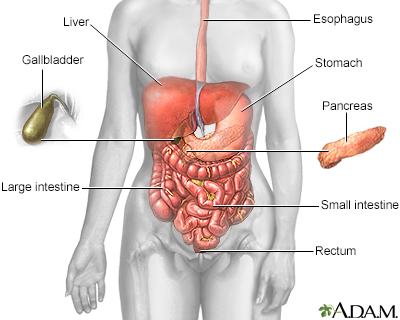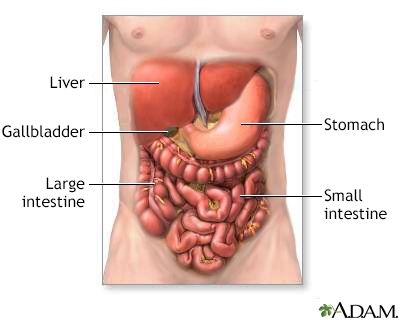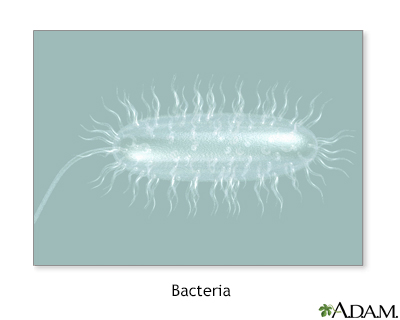Shigellosis
Shigella gastroenteritis; Shigella enteritis; Enteritis - shigella; Gastroenteritis - shigella; Traveler's diarrhea - shigellosis
Shigellosis is a bacterial infection of the lining of the intestines. It is caused by a group of bacteria called Shigella.

The esophagus, stomach, large and small intestine, aided by the liver, gallbladder and pancreas convert the nutritive components of food into energy and break down the non-nutritive components into waste to be excreted.

The digestive system organs in the abdominal cavity include the liver, gallbladder, stomach, small intestine and large intestine.

Bacterial infections can lead to the formation of pus, or to the spread of the bacteria in the blood.

If you have stomach cramps, diarrhea, fever, or nausea a few hours after eating something, chances are you may have food poisoning. Let's talk about food poisoning. Food poisoning happens when you eat food or drink water that's been contaminated with bacteria, parasites, viruses, or toxins. Most cases of food poisoning are due to common bacteria, such as Staphylococcus or E. coli. Bacteria may get into your food in different ways. Meat or poultry may come into contact with intestinal bacteria when it gets processed. Water that's used during growing or shipping may contain animal or human waste. Food poisoning may also occur when people handle your food without washing their hands properly, when food is prepared using unclean cooking utensils or cutting boards, when perishable foods are left out of the refrigerator for too long, and when people eat raw foods like fish or oysters or undercooked meats or eggs. Untreated water can also cause food poisoning. So, what do you do about food poisoning? Well, fortunately, you'll usually recover from the most common types of food poisoning within 12 to 48 hours. Your goal should be to make sure that your body gets enough fluids so that you don't become dehydrated. Don't eat solid foods until diarrhea has passed, and avoid dairy products. Drink any fluid (except milk and caffeinated beverages) to replace fluids in your body. If you have eaten toxins from mushrooms or shellfish, seek medical attention right away. The emergency room doctor will then empty out your stomach and remove the toxin. Most people will recover from the most common types of food poisoning pretty quickly. However, if food poisoning leads to dehydration because you can't keep anything down, you should seek immediate medical attention.
Causes
There are several types of Shigella bacteria, including:
- Shigella sonnei, also called "group D" Shigella, is responsible for most cases of shigellosis in the United States.
- Shigella flexneri, or "group B" Shigella, causes almost all other cases.
- Shigella dysenteriae, or "group A" Shigella is rare in the United States. However, it can lead to deadly outbreaks in developing countries.
People infected with the bacteria release it into their stool. They can spread the bacteria to water or food, or directly to another person. Getting just a little bit of the Shigella bacteria into your mouth is enough to cause infection.
Outbreaks of shigellosis are linked to poor sanitation, contaminated food and water, and crowded living conditions.
Shigellosis is common among travelers in developing countries and workers or residents in refugee camps.
In the United States, the condition is most commonly seen in daycare centers and places where groups of people live, such as nursing homes.
Symptoms
Symptoms often develop about 1 to 7 days (average 3 days) after coming into contact with the bacteria.
Symptoms include:
- Acute (sudden) abdominal pain or cramping
- Acute fever
- Blood, mucus, or pus in the stool
- Crampy rectal pain
- Nausea and vomiting
- Watery and bloody diarrhea
Exams and Tests
If you have symptoms of shigellosis, your health care provider will check for:
- Dehydration (not enough fluids in your body) with a fast heart rate and low blood pressure
- Abdominal tenderness
- Elevated level of white blood cells in the blood
- Stool culture to check for the presence of the bacteria
Treatment
The goal of treatment is to replace fluids and electrolytes (salt and minerals) that are lost in diarrhea and stop the infection with antibiotics.
Medicines that stop diarrhea are generally not given because they can cause the infection to take longer to go away.
Self-care measures to avoid dehydration include drinking electrolyte solutions to replace the fluids lost by diarrhea. Several types of electrolyte solutions are available over-the-counter (without a prescription).
Antibiotics can help shorten the length of the illness. These medicines also help prevent the illness from spreading to others in group living or daycare settings. They may also be prescribed for people with severe symptoms.
If you have diarrhea and cannot drink fluids by mouth because of severe nausea, you may need medical care and intravenous (IV) fluids. This is more common in small children who have shigellosis.
People who take diuretics ("water pills") may need to stop taking these medicines if they have acute Shigella enteritis. Never stop taking any medicine without first talking to your provider.
Outlook (Prognosis)
The infection can be mild and goes away on its own. Most people, except malnourished children and those with weakened immune systems, typically recover fully.
Possible Complications
Complications may include:
- Dehydration, severe
- Hemolytic-uremic syndrome (HUS), a form of kidney failure with anemia and clotting problems
- Reactive arthritis
About 1 in 10 children (under age 15) with severe Shigella enteritis develop nervous system problems. These may include febrile seizures (also called a "fever fit") when body temperature rises quickly and the child has seizures. A brain disease (encephalopathy) with headache, lethargy, confusion, and stiff neck can also develop.
When to Contact a Medical Professional
Contact your provider if diarrhea does not improve, if there is blood in the stool, or if there are signs of dehydration.
Go to the emergency room if these symptoms occur in a person with shigellosis:
- Confusion
- Headache with stiff neck
- Lethargy
- Seizures
These symptoms are most common in children.
Prevention
Prevention includes properly handling, storing, and preparing food, and good personal hygiene. Handwashing is the most effective way to prevent shigellosis. Avoid food and water that may be contaminated.
References
Fleckenstein JM. Approach to the patient with suspected enteric infection. In: Goldman L, Cooney KA, eds. Goldman-Cecil Medicine. 27th ed. Philadelphia, PA: Elsevier; 2024:chap 262.
Kotloff KL. Acute gastroenteritis in children. In: Kliegman RM, St. Geme JW, Blum NJ, et al, eds. Nelson Textbook of Pediatrics. 21st ed. Philadelphia, PA: Elsevier; 2020:chap 387.
Lima AAM, Warren CA, Guerrant RL. Acute dysentery syndromes (diarrhea with fever). In: Bennett JE, Dolin R, Blaser MJ, eds. Mandell, Douglas, and Bennett's Principles and Practice of Infectious Diseases. 9th ed. Philadelphia, PA: Elsevier; 2020:chap 99.
MacLennan CA. Shigellosis. In: Goldman L, Cooney KA, eds. Goldman-Cecil Medicine. 27th ed. Philadelphia, PA: Elsevier; 2024:chap 285.
Melia JMP, Sears CL. Infectious enteritis and proctocolitis. In: Feldman M, Friedman LS, Brandt LJ, eds. Sleisenger and Fordtran's Gastrointestinal and Liver Disease. 11th ed. Philadelphia, PA: Elsevier; 2021:chap 110.
Version Info
Last reviewed on: 3/16/2024
Reviewed by: Jatin M. Vyas, MD, PhD, Associate Professor in Medicine, Harvard Medical School; Associate in Medicine, Division of Infectious Disease, Department of Medicine, Massachusetts General Hospital, Boston, MA. Also reviewed by David C. Dugdale, MD, Medical Director, Brenda Conaway, Editorial Director, and the A.D.A.M. Editorial team.
